What is good about the Cherriet radish hybrid and why is it worth growing?
The varieties of Japanese selection are so versatile that they take root in any climate zone. Summer residents have understood this for a long time and are happy to cultivate various crops from the Land of the Rising Sun on their plots. In the state register, a significant proportion of varieties and hybrids grown in Russia are of foreign origin. One of them is Cherryat radish f1. This is a first generation hybrid, resistant to flowering and characterized by rich yields.
What kind of radish is this
Radish hybrid Cherryet f1 was bred by Japanese breeders from the Sakata company.. In 2007, the culture was included in the State Register of Russia and recommended for breeding in all regions of the country.

Any hybrid is obtained by crossing two pure varieties, from which it inherits the strongest qualities. Therefore they are considered more adapted to unfavorable climatic conditions and more resistant to diseases of its family.
Historical reference! The radish was obtained in the Middle Ages as a result of breeding experiments with radishes.
Characteristics and description
This is a mid-late radish - fruiting occurs 20 days after germination. It takes root equally well both in open ground and in greenhouse conditions. The culture is bred not only for personal use, but also on an industrial scale.
The leaves are smooth, low, strong, gray-green in color.. The crop is resistant to flowering, that is, it does not form shoots, so it can be grown all year round.
The genes of the variety contain high resistance to diseases such as clubroot, Fusarium leaf wilt and blackleg.
Main distinguishing feature – no obvious need for long daylight hours.
Description of fruits
Round shape, bright red, rich color, average weight 25-35 g. The pulp is juicy, tender, without voids, and not prone to cracking in unfavorable conditions. The taste is traditional, slightly spicy.
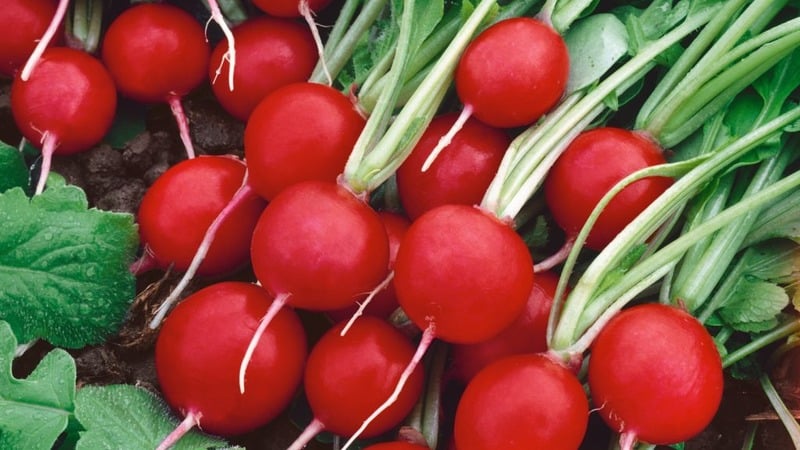
Ripe vegetables tolerate long-term transportation well. They are stored for a long time, up to one month.
Due to its beneficial composition, radishes are often called “natural vitamins.” It is suitable for consumption whole, in salads, and serves as a decoration for side dishes.
Reference! Ripe radishes contain magnesium, potassium, iron and phosphorus.
Productivity
Productivity is high - from 1 sq. m harvest up to 3 kg of fruits. The fruits are almost the same size, even. Ripe vegetables retain their presentation and taste for a month. For these reasons, the crop is popular among entrepreneurial farmers.
Growing a hybrid
Cherriet radish seeds from the manufacturer “Sakata” do not require additional processing. They are already ready for sowing: disinfected and treated with nutrients to improve growth.
Other varieties and hybrids of radish:
A productive and easy-to-care variety of Duro radish
Landing
Due to their cold resistance, radishes can be sown in early spring. under a film cover or in open ground when the soil warms up to 15°C.
The soil is slightly acidic or neutral, light and fertile. For lightness, add river sand, which acts as a leavening agent, and peat will make the soil fertile.
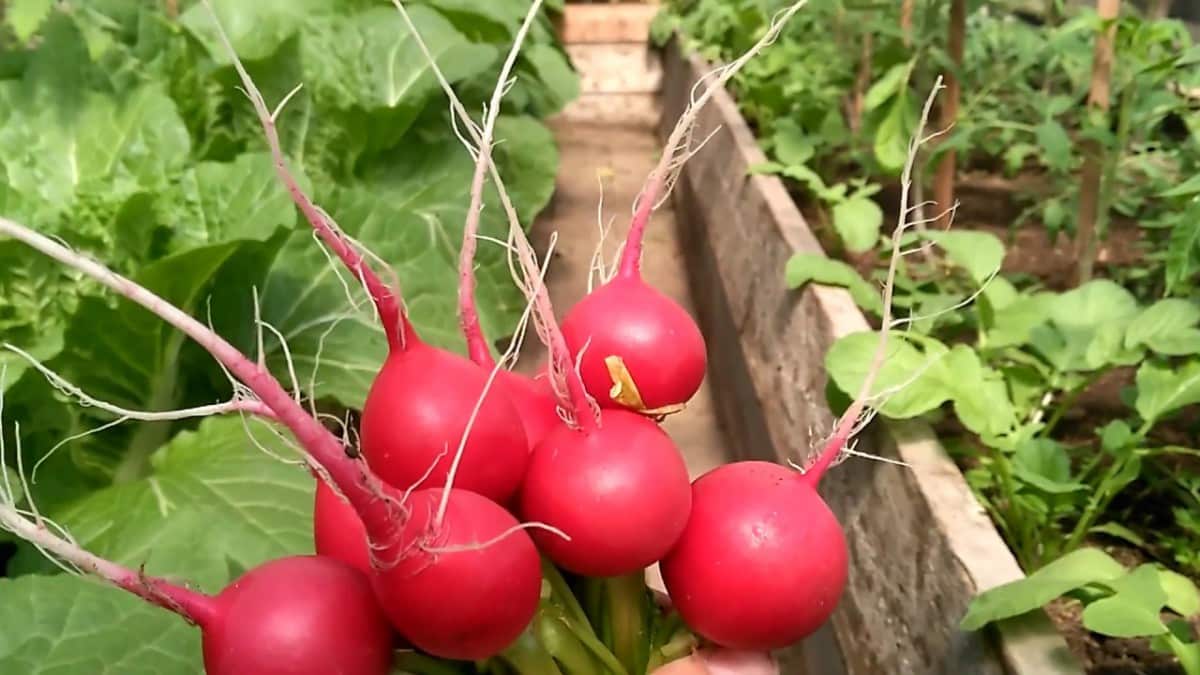
If the acidity is high, slaked lime or dolomite flour is added to the soil.. The acidity level (pH) is determined with a litmus indicator. Add a little earth to a glass of water, stir thoroughly and dip litmus paper into the solution. If it turns red, the pH is increased.
Reference! Increased acidity is indicated by the appearance of sorrel, sedge and plantain at the dacha.
Seeds are sown to a depth of 1.5 cm with a distance of 5 cm between holes. Leave 15 cm between the rows. After sowing, the holes are filled with peat and the surface is lightly sprinkled with warm water.
At a temperature of 12-15°C, seedlings will appear in 4-6 days. In colder weather, seed germination will take up to 7-10 days.
Care
The main thing in care is proper watering. Water the hybrid abundantly and often to prevent the soil from drying out. If there is a lack of moisture, the fruits will begin to crack. There is no need to flood the beds, as excess moisture threatens the spread of fungal infections. In addition, the fruits acquire a watery taste.
To prevent the beds from drying out longer, they are mulched. straw or sawdust. Mulch, in addition to retaining moisture, performs a preventive function in pest control.
Since the vegetative period of radish is short, it does not need fertilizing.. It is enough to add humus to the dug soil two weeks before sowing, thereby saturating the soil with additional nutrients necessary for full growth.
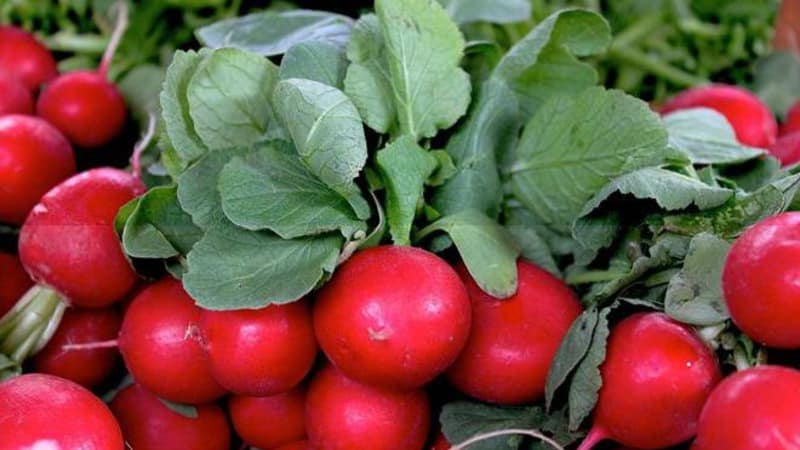
Diseases and pests
Although the culture is highly resistant to diseases of the cruciferous family, if the irrigation regime and crop rotation rules are violated, the hybrid fungal infections cannot be excluded.
Downy mildew appears on the leaves as a white powdery coating.. This plaque then spreads throughout the plant, causing the seedlings to wither and die. In order to prevent the disease from entering the beds, it is necessary to maintain a distance of at least 5 cm between the holes when planting. Densified plantings promote the transfer of fungal spores. Also, during the growth of seedlings, they are sprayed with the fungicidal agent “Fitosporin”, which not only protects against infections, but also strengthens the plant’s immunity.
Cruciferous flea beetles cause irreparable damage to very young plants. Therefore, after sowing, the beds are covered with non-woven material, which allows air and light to pass through, but does not allow pests to get inside. After two weeks, cruciferous flea beetles are less dangerous for seedlings, since by that time they have become coarser and do not attract the pest.
Also for prevention against insect infestation seedlings are sprayed with infusion of onion peels or plantain decoction.

Harvesting and application
Strong radish leaves allow you to pull the root crop out of the ground easily, without damage.. All fruits are smooth, round, approximately the same weight and size and have an attractive presentation. Cherriet radishes do not linger on the shelves.
Fruits are stored for a long time without losing their taste. They can be transported anywhere in the country; the fruits do not wither or crack.
In cooking, radishes are used to prepare salads and decorate dishes.
Read also:
Caring for Celeste radishes to get tasty and large fruits
Review of the best radish varieties for open ground and greenhouses
Features of growing in a greenhouse
In the greenhouse, root crop seeds are sown as early as March. and throughout the year if the greenhouse is heated.In the cold season, grain germination is delayed for several days. Full lighting is required throughout the entire period of growth and development, otherwise fruiting will also occur later.
The planting scheme is of particular importance: in greenhouses, grains are sown at a distance of 6-7 cm from each other. When thickened, pests and fungal spores multiply quickly. Also, pathogens love high humidity and air temperature. Therefore, the greenhouse is ventilated every day, avoiding drafts.
As soon as the shoots appear, the temperature is lowered to 8-10°C and moderate watering is maintained. During fruit formation, the temperature is maintained at 16°C, and watering is increased, otherwise the fruits will not gain weight.
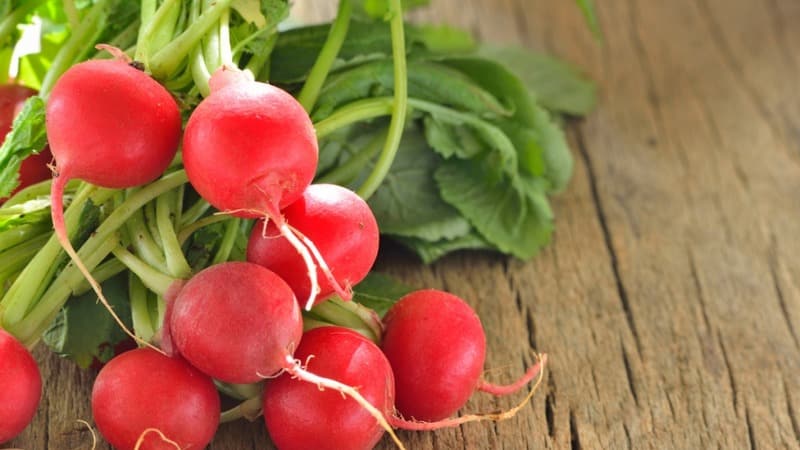
Open ground cultivation
Even despite the hot climate and long daylight hours, in the summer Cherryet does not form flower shoots, as many other varieties do. Therefore, when exposed to sunlight, it is not necessary to shade it. The main thing is to ensure timely and competent watering.
Seed material is sown in open beds even in the middle of summer, since at any time of the year the hybrid forms root crops and not barren flowers.
According to the rules of crop rotation, seed material is sown in beds where tomatoes or cucumbers previously grew.. These are the best predecessors of radishes. But the hybrid cannot be planted in those beds where cabbage family crops grew. Such soil will not provide the seedlings with the necessary nutrients. And onions and carrots will be good neighbors for the crop.
So that the seedlings grow well, before sowing, add a full range of minerals to the soil, in addition to peat and humus. This is quite enough and in the future the plant does not need to be fed.But if you notice that the radishes are not growing well, water the seedlings with a solution of ash in the proportion of one glass per 10 liters of water.
Reference! Potassium contained in the ash is well absorbed by plants and promotes rapid ripening of fruits.
Advantages and disadvantages
The main advantage of the Cherriet hybrid is its high resistance to bolting, despite unfavorable factors.
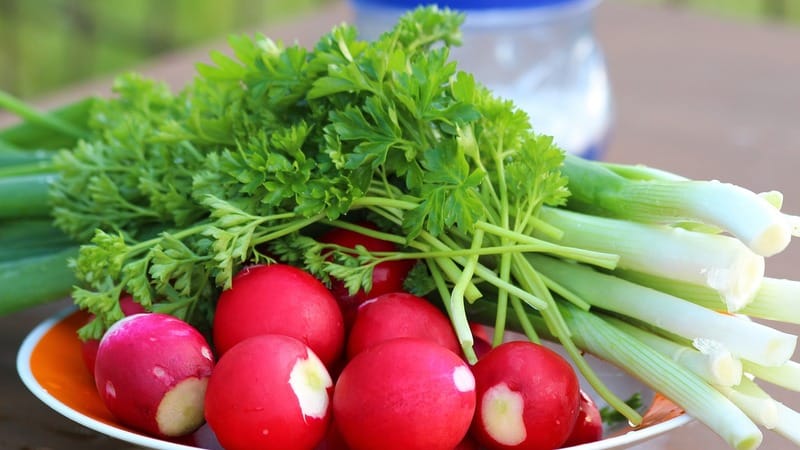
Other useful properties:
- high yield;
- increased immunity to diseases;
- simple agricultural technology;
- absence of voids in the fruits;
- excellent taste;
- long storage;
- duration of transportation;
- Possibility of breeding for sale.
The only problem - the impossibility of independently collecting seeds for the next planting.
Farmer reviews
According to farmers, Cherryat f1 radish is exactly the crop that should be grown in any region, regardless of the scale of production. Root crops are good for both personal farming and commercial purposes.
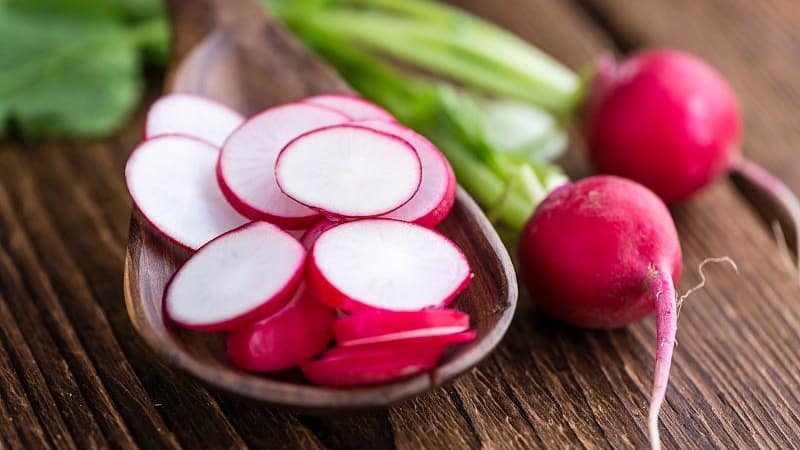
Anton, Bryansk: “I liked the Japanese hybrid for its yield and fruit size. With good watering, the root crops reached 5-6 cm, which is quite consistent with the advertising photos. Moreover, these giants have no voids inside; they are juicy and tasty. I sowed seeds in a greenhouse during frosts, and later in open ground. I didn’t observe any bolting, despite the hot summer.”.
Varvara, Omsk: “I planted Cherriet and understood why gardeners choose imported seeds. The leaves are small, and the fruits are juicy and tasty. Growing it is a pleasure, absolutely no problems during the growing season and no diseases. The taste is more sweet than spicy, which suits me quite well.”.
Conclusion
Farmers advise everyone who wants to enjoy the taste of sweet and juicy radishes to grow the hybrid Cherriet f1.It is easy to care for and produces rich harvests. Resistance to bolting allows the hybrid to be grown in greenhouses at any time of the year and used for commercial purposes.